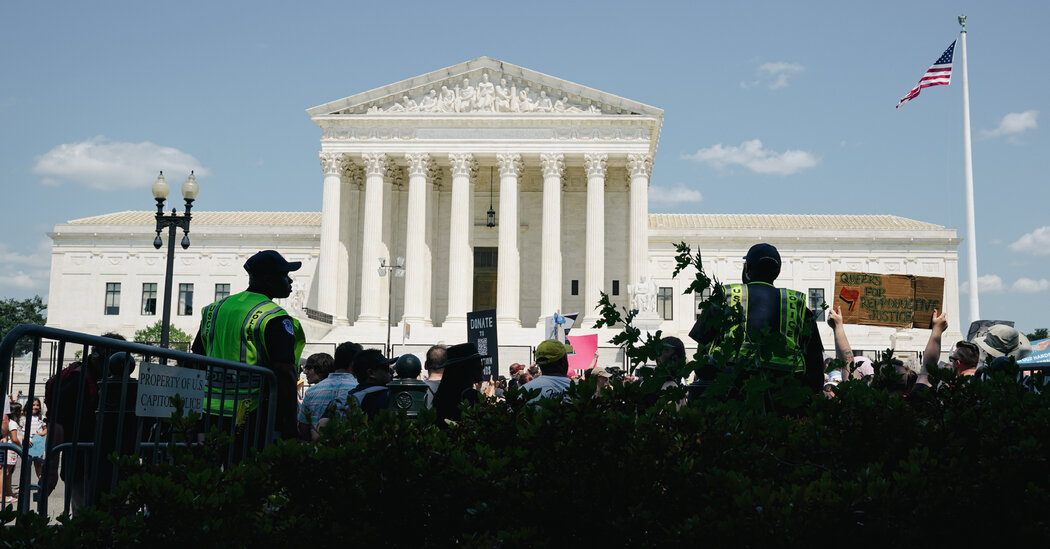In the year since the Supreme Court overturned Roe v. Wade, some of the results of the decision have been unsurprising — more than a dozen Republican-
In the year since the Supreme Court overturned Roe v. Wade, some of the results of the decision have been unsurprising — more than a dozen Republican-led states have moved to ban most abortions, and dozens of abortion clinics have closed. Yet there have also been unexpected legal and political changes that have left Americans on both sides of the issue scrambling to adapt. Here are five major changes detailed in The New York Times’s coverage of the first anniversary of the decision in Dobbs v. Jackson Women’s Health Organization, which ended the constitutional right to abortion after nearly 50 years.
Some Republicans are struggling on the issue.
The Dobbs decision has reshaped the national political landscape in two seemingly contradictory ways. It has made abortion rights a significant electoral strength for Democrats and, often, a clear liability for Republicans. And yet, Republican-dominated states have moved swiftly to limit or ban access to abortion.
Those dueling forces have left some Republican lawmakers, strategists and activists struggling to find a consensus on abortion policy, and grappling with how to energize the party’s base on the issue without alienating swing voters.
Abortion policy has become particularly fraught for Republicans in competitive districts, as well as for some presidential candidates, whose uneasy attempts to strike a balance on the issue have highlighted the tensions rippling through the party in the post-Roe era.
New polling shows more support for abortion rights.
Polling over the last year has detected a notable shift in public opinion after decades of relative stasis: For the first time, a majority of Americans say abortion is “morally acceptable.” A majority of them now believe abortion laws are too strict. And for the first time in two decades, Americans are significantly more likely to identify as “pro-choice” than “pro-life.”
The increase in support for abortion rights could affect the 2024 presidential election. More voters than ever say they will vote only for a candidate who shares their views on abortion. But Republicans and those who identify as “pro-life” are less motivated by the issue than Democrats and those who identify as “pro-choice,” who are far more concerned about abortion rights.
“This is a paradigm shift,” said Lydia Saad, the director for U.S. social research for Gallup, the polling firm. “There’s still a lot of ambivalence, there aren’t a lot of all-or-nothing people. But there is much more support for abortion rights than there was, and that seems to be here to stay.”
Clinics are closing, and not only in states with abortion bans.
In the year since Roe v. Wade was overturned, at least 61 clinics, Planned Parenthood facilities and doctors’ offices have stopped offering abortions. While most were in states that banned abortion outright, others closed because of the uncertain legality of abortion in their states. The closures forced many women to travel to states, such as Illinois and North Carolina, where abortion is legal. Clinics in those states have experienced an increase in demand.
About half of the providers that stopped providing abortions have shifted to offer other services, such as birth control and prenatal care. And at least a dozen providers opened new clinics in states that do not ban abortion.
Across the country, the number of average monthly abortions fell by about 3 percent in the nine months after the Supreme Court ruling.
Religious freedom arguments are fueling the fight against abortion bans.
For years, conservative Christians have cited the principle of religious freedom to secure legal victories in battles over issues like contraceptive insurance mandates and coronavirus pandemic restrictions. Now, abortion rights supporters are invoking the same principle to fight state abortion bans.
Since Roe v. Wade was overturned, clergy members and followers of various religions, including Christian and Jewish denominations, have filed at least 15 lawsuits in at least eight states, saying abortion bans infringe on their faiths. Many argue that their religious beliefs permit abortion in at least some circumstances, and that bans violate religious freedom and the separation of church and state.
The lawsuits, which are still in the early stages, show “religious liberty doesn’t operate in one direction,” said Elizabeth Sepper, a law professor at the University of Texas at Austin.
Guam might show what post-Roe America could look like.
The tiny island of Guam, an American territory 1,600 miles south of Japan, has become the purest laboratory of what life might look like if abortion were banned entirely in the United States.
Though abortion is legal up to 13 weeks in Guam, the last abortion doctor left the island in 2018. The closest state in America with an abortion clinic is Hawaii, an eight-hour flight away. A pending court case could cut off access to abortion pills, the last legal method by which most women on Guam are able to end their pregnancies. And there is a push on the island to revive a near-total ban on abortions that was passed in 1990 and has been blocked by courts for three decades.
“Guam is a litmus test,” said Attorney General Douglas Moylan, a Republican who opposes abortion and appealed to the federal courts to lift the injunction on the 1990 ban. “If anti-abortion forces were to succeed anywhere in the United States, I would say Guam would be one of them.”
www.nytimes.com
